World Tapas Day is celebrated on June 16th. That’s how important tapas are in Spain! The Saborea España Association was the promoter of this event that was held for the first time on June 16th, 2012. And in 2018, the Spanish Government began the procedures to declare Spanish tapas Intangible Cultural Heritage of Humanity.
There are hundreds… no! Thousands of tapas in Spain! Some tapas are traditional local specialities, lesser known, but exquisite and with a very interesting history behind them. Other tapas are the popular ones, the ones that wherever you go in Spain, you will find in our bars, restaurants and chiringuitos. They are the most popular Spanish tapas.
But before we start with the top 10 most popular Spanish tapas, think about this question:
What do you like the most about your Spanish lessons?
Maybe it’s reading texts or maybe it’s listening to audios. Maybe it’s practising conversation or maybe it’s grammar 😉. I don’t know, because every learner has a skill that they’re better at. What I can say is that you all love to learn more about the cultural part of the language: history, art, traditions, music, literature, natural parks… and of course, gastronomy.
That’s why I know you’re going to enjoy this article especially. And if you’ve been to Spain before, you’ve probably already tried some of the most popular Spanish tapas from this list.
In all languages there is a popular jargon and a way of interacting with others that is due to the culture of the society that speaks that language. In the case that concerns us in this article, the most popular Spanish tapas, there are some expressions, verbs and nouns that are directly related to them.
Teachers explain all these cultural aspects linked to the language in our Spanish lessons. Let’s begin seeing the difference between tapa, pincho and ration, which is a fairly common question among students.
Tapeo is the action of having drinks (usually wine or beer) and tapas and tapear or ir de tapas consists of consuming a drink and a tapa in a bar or a restaurant and when we finish, we go to a new place to consume another drink and another tapa, and so on.
We are going to see some of these expressions with examples, just as we would do in our Spanish lessons:
– ¿Te gusta ir de tapas?
– Sí, me encanta. En mi familia tapeamos mucho. Especialmente los fines de semana.
– Entonces, ¿es común en España ir de tapas?
– Sí, el tapeo es una de nuestras señas de identidad. ¡Por eso tenemos tantas tapas riquísimas en España!
– ¿Y cuáles son las tapas más populares de España?
Actually I have included more than ten tapas in this list… It is not easy to select only ten! And less at this time when I’m writing this article (I’m going to dinner in about 20 or 30 minutes 😂).
I will start the list of the most popular Spanish tapas with my dad ‘s favourite tapa: boquerones en vinagre con patatas fritas. It is a classic in all neighbourhood bars in Spain. This tapa is so popular that you can even buy it already prepared in supermarkets.
It consists of marinating the boquerones (a small fish) in salt, water and vinegar. Afterwards, they are washed and preserved in olive oil, with garlic and parsley. They are served with olives and chips.
Although Spain is the country that consumes them the most, the croquettes originate from France. Its success in France was such that it crossed the border with Spain during the War of Independence (1808 – 1814) and we adopted the recipe (and improved it).
The most classic ones are made with the leftovers of stew or with ham, although they can be made from any ingredient (cod croquettes are becoming popular). It consists of adding the ingredients to the béchamel cream, shaping it into a croquette, coating them in egg and breadcrumbs and frying them in abundant olive oil.
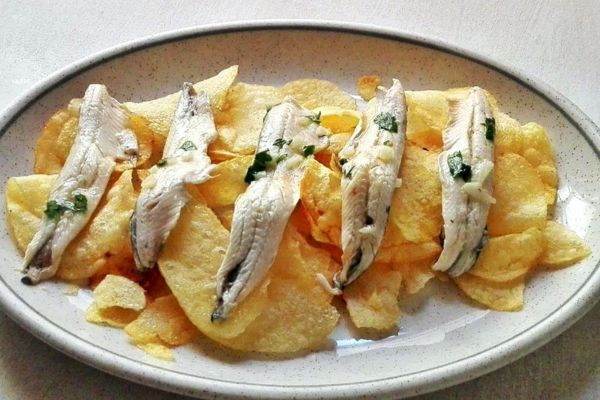
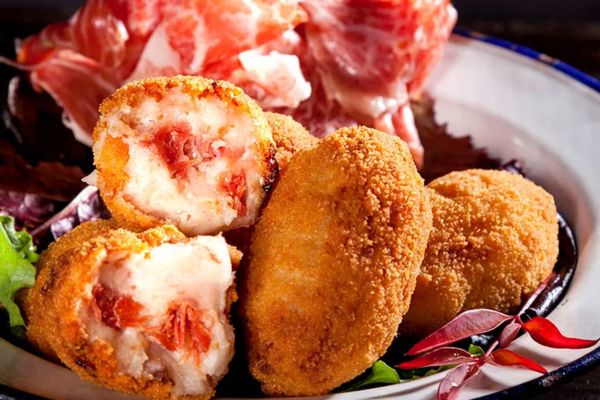
Torreznos is fried pork rind and it is typical of both Castillas. Torreznos from Soria are very famous, but you can find delicious, high-quality torreznos in many bars and restaurants in Spain. Since 2013, torreznos from Castilla y León have been declared an Intangible Heritage of Humanity by UNESCO.
On the other hand, the bull tail has been cooked since Roman times, although its origin in Spanish cuisine takes place in Córdoba, in the 16th century. This dish was prepared with the tails of fighting bulls, after the bullfights.
The bull or cow tail is cooked like a stew with onion, tomato, pepper, carrot, salt and bay leaf and a glass of red wine. It is a very typical tapa in the Andalusia region.
Here we have the princess of our gastronomy (as paella is the queen).
The first written reference to the Spanish tortilla or potato omelette dates from 1767 (La Agricultura General, Volume III, by Joseph Antonio Valcárcel). The ingredients used to cook it are: eggs, potatoes, onion (optional), olive oil and salt.
It is not surprising that you can find this tapa in any bar or restaurant in Spain, since the ingredients are easy to find and cheap.
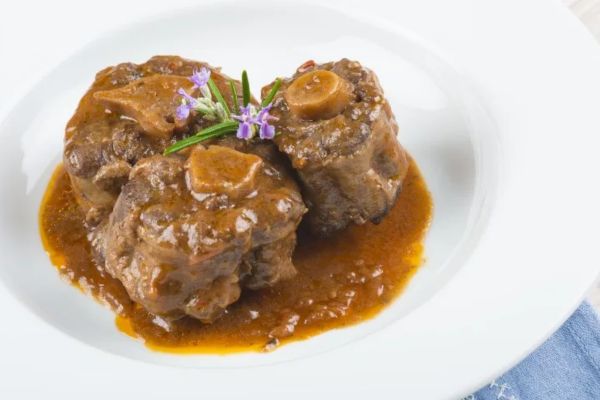
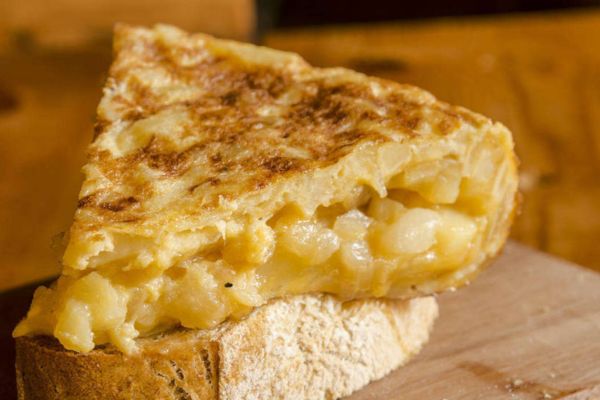
The Russian salad is a cold tapa that can be eaten all year round, although I particularly like to eat it in summer with a side of chips.
The Russian salad has cooked vegetables seasoned with mayonnaise. I like to make it with potatoes, carrots, peppers, peas, green beans, asparagus and olives. I also add a boiled egg and a can of tuna. Then I mix everything with mayonnaise.
It is very easy to prepare and, if you keep it in the fridge, it can last several days. But, why is it called Russian? There is apparently no clear connection between the origin of this dish and Russia. It seems that this salad, with cooked ingredients and seasoned with mayonnaise, has always been a typical dish in many European countries and has always been known as Russian salad.
Pickles are a type of food that is marinated in salted water or vinegar and left to ferment. This allows food to be kept for months, which is why it is a widespread technique throughout the world originating since ancient times.
In Spain gherkins, olives, onions, carrots, chilli peppers, peppers are pickled… And one way to present these small delicacies in the form of a tapa is with banderillas.
A banderilla is a wooden toothpick into which a variety of pickles are pierced. Normally, other ingredients are also added to make it more varied and delicious, such as prawns, anchovies or octopus.

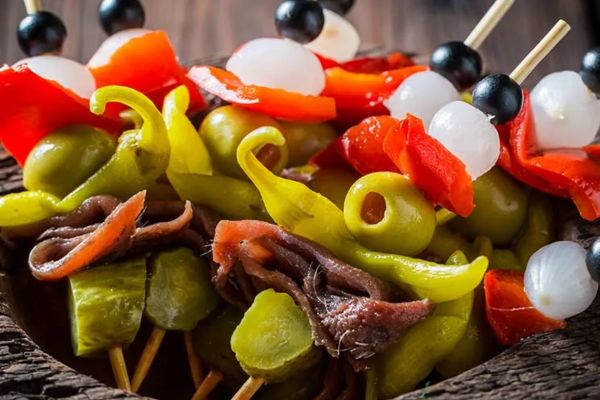
Iberian ham and sausages (loin, chorizo and salchichón) are highly valued delicacies of Spanish and Portuguese gastronomy. They are produced from the meat of the Iberian pig. The highest quality Iberian hams and sausages are those that come from pigs raised in the holm oak meadows and grasslands, in the western half of the centre and south of the Iberian Peninsula.
These pigs, raised in semi-freedom (feed on acorns, natural pastures) walk a lot, they “exercise”, which provides a very high quality raw material for the production of hams and sausages.
Manchego cheese (the most famous and marketed in Spain) is made from Manchego sheep’s milk and is protected by a Designation of Origin that covers part of the provinces of Ciudad Real, Toledo, Cuenca and Albacete, the so-called region of La Mancha, known worldwide thanks to the novel Don Quixote by Cervantes.
The patatas bravas is a dish that originated in the bars of Madrid, back in 1950. They are cubes of potatoes fried in olive oil and seasoned with salsa brava, which is a spicy sauce made from paprika.
In the Levante region (east coast of Spain, close to the Mediterranean Sea), it is preferred to eat potatoes with aioli (garlic and oil). In this case, the potato cubes are cooked in water and salt and then a white sauce made from olive oil and garlic (aioli) is added.
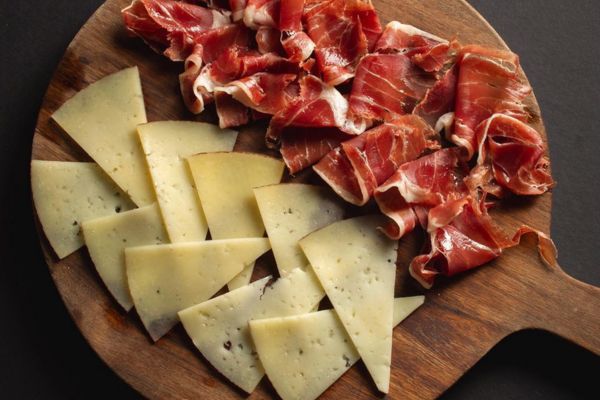
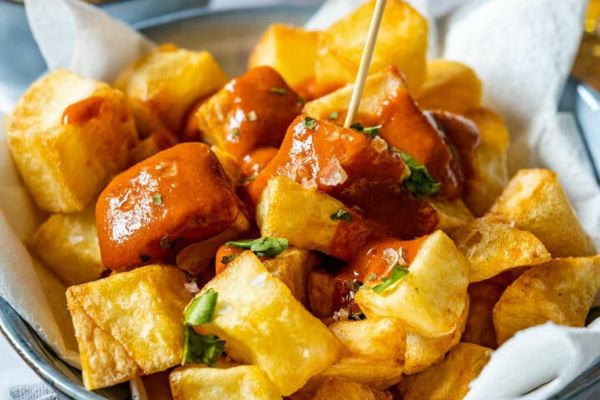
Galician octopus is one of the most popular dishes of Galician gastronomy, although today it is consumed throughout Spain and is served as a tapa.
Traditionally, the whole octopus is cooked in copper pots and it is a tradition to consume it in the popular festivals of the towns and cities of Galicia. In Carballino (Orense) since 1962 every year on the second Sunday of August the Octopus Festival is celebrated, declared of National Tourist Interest.
The cooked octopus is served on boiled potatoes. On top, sweet paprika, a drizzle of olive oil and some grains of coarse salt are added.
This tapa is always served in the traditional clay pot. It is very typical of central and southern Spain.
The ingredients are peeled prawns, garlic, olive oil, parsley and sometimes sliced chilli peppers are also added to give it a spicy flavour.
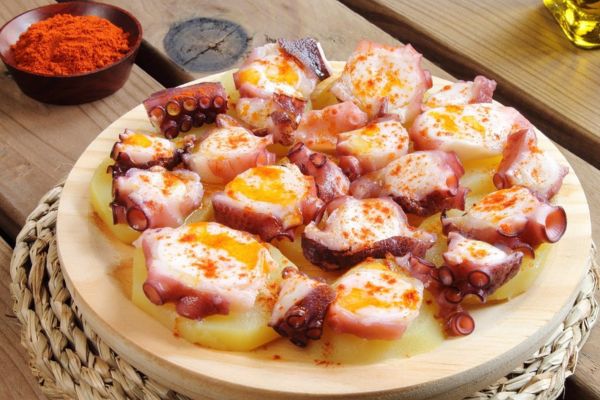
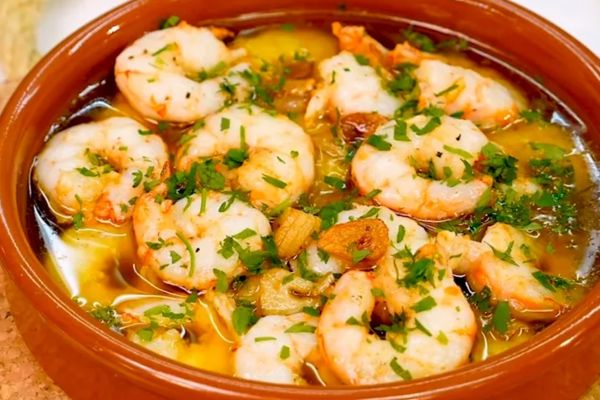
If you have enjoyed reading this article about the most popular Spanish tapas, you can continue to do so with our online Spanish lessons at Your Spanish Hub.
Expand your knowledge of Spanish culture and learn Spanish in a well-structured way with the guidance of an accredited native teacher. You can take a look at our catalogue of Spanish classes or our Membership Programme. You can also book your trial class with us today and meet your teacher.
I don’t know about you, but I’m thinking about next weekend and what tapas I’m going to order at the bar. Next Saturday I have a family dinner to celebrate my uncle’s birthday, and as you can imagine, before dinner, we are going to have some tapas and drinks… I’m sure that some of the tapas in this article will be on our menu!
